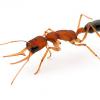- Formiculture.com
- Forums
- Gallery
- Members
- Member Map
- Chat

AdamL's capturing of a wild colony
Started By
AdamL
, Mar 10 2020 3:26 PM
9 replies to this topic
#1
 Offline
-
Posted March 10 2020 - 3:26 PM
Offline
-
Posted March 10 2020 - 3:26 PM
I have recently decided to capture a mature,wild ant colony (I know its mature as I saw elates at the nest entrance. I don't know if I will be abel to capture the colony in its entirety queen and everything. I researched how to capture wild colonys of ants but it's mainly done with brute force. I will be captureing this colony by putting a test tube next to there entrance and covering it, and letting them move in.
After about 22 hours I checked on them and saw that they had about 30 workers in the tube and about 1 third was holding larva. This would be a very effective brood boosting technique if I knew the species (its ether tetramorium or tapinoma), some brood boosting techniques take weeks to months, for now that it.
After about 22 hours I checked on them and saw that they had about 30 workers in the tube and about 1 third was holding larva. This would be a very effective brood boosting technique if I knew the species (its ether tetramorium or tapinoma), some brood boosting techniques take weeks to months, for now that it.
#2
 Offline
-
Posted March 10 2020 - 3:55 PM
Offline
-
Posted March 10 2020 - 3:55 PM
You could post an ID thread.
"God made..... all the creatures that move along the ground according to their kinds (including ants). And God saw that it was good. Genesis 1:25 NIV version
Keeping:
Formica cf. pallidefulva, cf. incerta, cf. argentea
Formica cf. aserva, cf. subintegra
Myrmica sp.
Lasius neoniger, brevicornis
#3
 Offline
-
Posted March 10 2020 - 4:11 PM
Offline
-
Posted March 10 2020 - 4:11 PM
I know I will
#4
 Offline
-
Posted March 10 2020 - 4:13 PM
Offline
-
Posted March 10 2020 - 4:13 PM
Just warning you that user ANTdrew might have, well, a few things to say about this... probably not good things...
Edited by TheMicroPlanet, March 10 2020 - 4:14 PM.
- ANTdrew likes this
#5
 Offline
-
Posted March 10 2020 - 4:20 PM
Offline
-
Posted March 10 2020 - 4:20 PM
Wait why?
#6
 Offline
-
Posted March 10 2020 - 4:22 PM
Offline
-
Posted March 10 2020 - 4:22 PM
He's not a huge fan about collecting wild colonies, but i'm not one to explain the details.
- ANTdrew likes this
#7
 Offline
-
Posted March 10 2020 - 4:23 PM
Offline
-
Posted March 10 2020 - 4:23 PM
Ok but I leting the ants capture them selfs.
#8
 Offline
-
Posted March 10 2020 - 4:30 PM
Offline
-
Posted March 10 2020 - 4:30 PM
That's messed up but would make AD's argument impaired, however you set up the proverbial trap thus giving him somewhat of a point
There is a important time for everything, important place for everyone, an important person for everybody, and an important ant for each and every ant keeper and myrmecologist alike
#9
 Offline
-
Posted March 10 2020 - 4:40 PM
Offline
-
Posted March 10 2020 - 4:40 PM
So this is a bad idea and I should stop?
#10
 Offline
-
Posted March 10 2020 - 5:09 PM
Offline
-
Posted March 10 2020 - 5:09 PM
Capturing a wild colony is risky. There’s the probability that the colony won’t adapt to captivity well, as they are used to fending for themselves in the wild. Forcibly digging up a colony can cause a lot of stress, and could lead to mass die offs. However, your method of capture won’t stress the colony nearly as much, so I don’t know.
"God made..... all the creatures that move along the ground according to their kinds (including ants). And God saw that it was good. Genesis 1:25 NIV version
Keeping:
Formica cf. pallidefulva, cf. incerta, cf. argentea
Formica cf. aserva, cf. subintegra
Myrmica sp.
Lasius neoniger, brevicornis
1 user(s) are reading this topic
0 members, 1 guests, 0 anonymous users

















